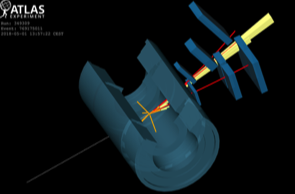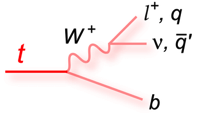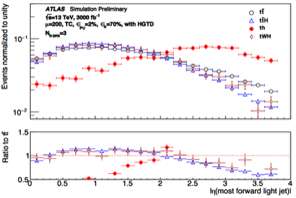
Dark Matter
While there is ample evidence for the existence of dark matter from astronomical observations, its microscopic nature still remains a mystery.
I am involved in searches for Dark Matter with the ATLAS experiment since 2017. I have led the mono-h(bb) search with the complete Run 2 dataset [Pex11] and played a key role in the combinations of dark matter searches in the context of models with extended Higgs sectors [Pex13].
I have convened the Common Dark Matter subgroup in ATLAS and the LHC Dark Matter Working Group.
I am collaborating with the theorist Dr. Ulrich Haisch to further explore the phenomenology of DM models with extended Higgs sectors and uncover new signatures that can be searched for at the LHC [Pr1,Pth2, Pth4].
Searches for New Physics
Dark Energy
The discovery of the apparent accelerated expansion of the observable universe has been one of the most unexpected findings in cosmology. A plethora of models have been suggested to explain DE, ranging from new fundamental fields to modifications of General Relativity. The elucidation of the nature of DE is a very active field of research in cosmology and particle physics with many experiments ongoing or under construction.
I have pioneered the first search for dark energy in ATLAS, based on the model proposed in 1604.04299; the results were presented in [Pex8].
I am also collaborating with Prof. Clare Burrage and Prof. Christoph Englert on the study of dark energy models through the Higgs sector [Pth3].

Matter-Antimatter Asymmetry
How matter dominated over antimatter in the Universe remains one of the biggest unsolved mysteries in particle physics.One of the simplest classes of baryogenesis models predicts that the matter-antimatter asymmetry is generated by the dynamics of the electroweak symmetry breaking mechanism. Since the SM Higgs boson cannot satisfy the conditions for baryogenesis, extensions of the SM Higgs sector have to be considered, with the simplest one being the 2 Higgs doublet model (2HDM).
Searches for cascade decays of heavy Higgs bosons (like A→ZH), that are considered to be the smoking gun signature of electroweak baryogenesis, have started being explored by ATLAS and CMS.
My group carried out the first search for cascade decays of heavy Higgs bosons in the Z(ll)H(tt) and Z(vv)H(bb) final states, which significantly extended the previously accessible parameter space [Pex14].

Improving the performance of the ATLAS detector
Identification of high-momentum b-jets
Some of the final states arising from heavy Higgs decays contain highly energetic heavy flavour jets. The B hadrons in these jets might decay after the first tracker layers, which makes the identifcation of these jets more difficult. We are investigating ways to improve the identification efficiency for such high-momentum heavy flavour jets, exploiting information from the inner tracker hits, by combining the ideas proposed in 1604.05036 with statte-of-the-art machine learning techniques.

Monte-Carlo event generators
Modelling of colour reconnection
With the top mass measurements becoming more and more precise, the modelling of colour reconnection, i.e. colour interactions during the hadronisation transition, has become one of the dominant sources of systematic uncertainty.
With Torbjorn Sjostrand, we developed a new set of colour reconnection models to assess the impact of colour reconnection on the measurement of the top mass.
The models were presented in [Pth1], which has become one of the main references in the field (>150 citations).


Improving MadSpin
I am collaborating with Dr. Olivier Mattelaer to improve the modelling of unstable particle decays using the MadSpin plug-in of the MadGraph_aMC@NLO event generator.

Previous research topics
Hlggs and top measurements
I have contributed to the measurements of the Higgs couplings in the bb [Pex4, Pex7, Pex9, Pex10] and WW [Pex12] decay channels.
I was analysis contact for the first measurement of the cross-section of the ttbb process [Pex1], which constituted the dominant background for the measurement of the top Yukawa coupling in the ttH(bb) channel.

High-Granularity Timing Detector
The High-Granularity Timing Detector is a new subdetector based on super-fast silicon diodes proposed for the Phase-II ATLAS upgrade to suppress pile-up in the forward region.
I studied the impact of the HGTD on the measurement of the top Yukawa coupling in the associated production of a Higgs boson with a single top quark [Patl2].

Identification and suppression of pile-up jets
For my PhD thesis, I contributed to the development of the jet-areas method for the suppression of pile-up jets [Pex2], which is now used by all ATLAS analyses (> 1000 citations).
I also developed a new methods to identify pile-up jets (see PhD thesis).
